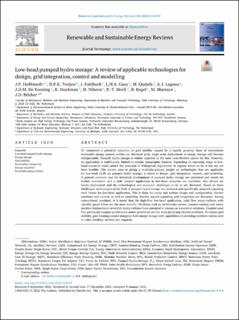| dc.contributor.author | Hoffstaedt, Justus | |
| dc.contributor.author | Truijen, Daan | |
| dc.contributor.author | Fahlbeck, Jonathan | |
| dc.contributor.author | Gans, Luiz Henrique Accorsi | |
| dc.contributor.author | Qudaih, Mohammed | |
| dc.contributor.author | Laguna, Antonio Jarquin | |
| dc.contributor.author | De Kooning, Jeroen | |
| dc.contributor.author | Stockman, Kurt | |
| dc.contributor.author | Nilsson, Håkan | |
| dc.contributor.author | Storli, Pål-Tore Selbo | |
| dc.contributor.author | Engel, Bernd | |
| dc.contributor.author | Marence, Miroslav | |
| dc.contributor.author | Bricker, Jeremy | |
| dc.date.accessioned | 2022-02-04T08:19:25Z | |
| dc.date.available | 2022-02-04T08:19:25Z | |
| dc.date.created | 2022-02-03T14:38:38Z | |
| dc.date.issued | 2022 | |
| dc.identifier.issn | 1364-0321 | |
| dc.identifier.uri | https://hdl.handle.net/11250/2977040 | |
| dc.description.abstract | To counteract a potential reduction in grid stability caused by a rapidly growing share of intermittent renewable energy sources within our electrical grids, large scale deployment of energy storage will become indispensable. Pumped hydro storage is widely regarded as the most cost-effective option for this. However, its application is traditionally limited to certain topographic features. Expanding its operating range to low-head scenarios could unlock the potential of widespread deployment in regions where so far it has not yet been feasible. This review aims at giving a multi-disciplinary insight on technologies that are applicable for low-head (2-30 m) pumped hydro storage, in terms of design, grid integration, control, and modelling. A general overview and the historical development of pumped hydro storage are presented and trends for further innovation and a shift towards application in low-head scenarios are identified. Key drivers for future deployment and the technological and economic challenges to do so are discussed. Based on these challenges, technologies in the field of pumped hydro storage are reviewed and specifically analysed regarding their fitness for low-head application. This is done for pump and turbine design and configuration, electric machines and control, as well as modelling. Further aspects regarding grid integration are discussed. Among conventional machines, it is found that, for high-flow low-head application, axial flow pump-turbines with variable speed drives are the most suitable. Machines such as Archimedes screws, counter-rotating and rotary positive displacement reversible pump-turbines have potential to emerge as innovative solutions. Coupled axial flux permanent magnet synchronous motor-generators are the most promising electric machines. To ensure grid stability, grid-forming control alongside bulk energy storage with capabilities of providing synthetic inertia next to other ancillary services are required. | en_US |
| dc.language.iso | eng | en_US |
| dc.publisher | Elsevier | en_US |
| dc.rights | Navngivelse 4.0 Internasjonal | * |
| dc.rights.uri | http://creativecommons.org/licenses/by/4.0/deed.no | * |
| dc.title | Low-head pumped hydro storage: A review of applicable technologies for design, grid integration, control and modelling | en_US |
| dc.type | Peer reviewed | en_US |
| dc.type | Journal article | en_US |
| dc.description.version | publishedVersion | en_US |
| dc.source.volume | 158 | en_US |
| dc.source.journal | Renewable & Sustainable Energy Reviews | en_US |
| dc.source.issue | 112119 | en_US |
| dc.identifier.doi | https://doi.org/10.1016/j.rser.2022.112119 | |
| dc.identifier.cristin | 1997443 | |
| cristin.ispublished | true | |
| cristin.fulltext | original | |
| cristin.qualitycode | 1 | |

